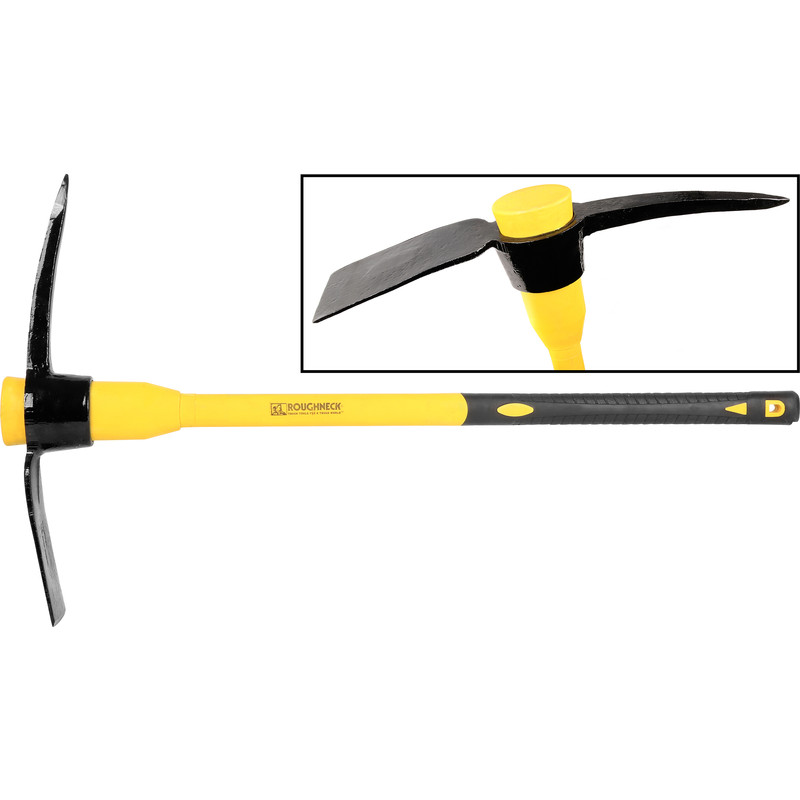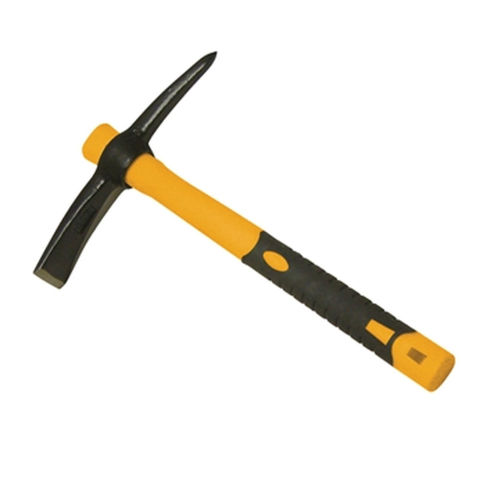![]() You don't need to be an 'investor' to invest in Singletrack: 6 days left: 95% of target - Find out more
You don't need to be an 'investor' to invest in Singletrack: 6 days left: 95% of target - Find out more
There's a place where a rocky trail in our woods flattens out and has collected a load of mud over the years to the point where it's not rideable in the winter. I've looked at it a lot and I think I can dig some drainage ditches and channels to help it drain and hopefully give the water somewhere to run so it washes the mud out.
I'm guessing a spade and a pickaxe are the best tools for this? The places I have to dig will probably have stones and spruce roots. Does anyone else do this? What tools did you use? My pick is rather heavy and it's a bit of a walk in especially if I can't drive to the car park!
One tool I've found useful for breaking rough ground is a mattock, sort of a cross between a pick axe and a spade.
Mattock much more useful for roots.
Pick/Mattock is my favourite digging tool. Perfect for narrow ditches. Probably just need the mattock bit but the pick helps with rocks.

For lighter work I have a baby one. Easy to carry in a pack. Might be enough for a small channel

Dig it out on any depressions or downslope, water will always try to go downhill even if it seems flat. Inside of corners can work as shit gets built up on the outside.
A trenching hoe is my tool of choice for this sort of thing.
Drill through the head to bolt it to the shaft to stop it spinning round or sliding down and smacking you on the head.
depends on what kind of mattock you buy,
an adze and root axe i'd say is better for diging and root cutting,
an adze and pick is better for breaking
As an alternative could you 'bridge' over it?
I think I know the answer...

If it's only 5 or 6 feet wide, and you can't carry a mattock on the bike to the section, I've a wee cheap folding spade, with a sharpened edge, that's okay for small drainage channel.
Gap jump!
Just looking at that micro mattock, there is a cutter version as well:
https://www.screwfix.com/p/roughneck-1lb-micro-cutter-mattock-15/11152
I bought one of those micro pick/mattocks for a different purpose but now I have it I'm thinking I'll take it out to address this section of trail.
I guess I'd want a micro shovel too, to move dirt and stones, but is there some kind of strong bag I can bring to move rocks about from other parts of the trail? Like one of those small blue IKEA bags but tougher?
Can I get like a garden trowel but tougher?
This looks great although not cheap:
https://www.crawfordsmd.com/ADEEXBLADE
Are you walking in or riding?
It’ll take way longer and be less effective with diddy tools.
I could do either. It's a reasonable walk, so I don't want to be dragging in full sized tools anyway if I can help it. But in any case I already own the full sized versions.
Mattock & trenching hoe are my tolls of choice for digging. Mattocks are great to break the ground up, or doing a lot of benching. Trenching hoe for lighter work & moving the dirt around.
Mini tools for 5 minutes of repair work, but I wouldn't want to do any sort of meaningful trail building with them.
It really depends on what type of stuff your digging into. Mattock for more heavy duty breaking, digging hoe for mud/loam, a spade is andy.
Clear the old mud first if you can to get a better idea of the natural shape/line
Try to create a shallow scoop in the lowest area rather than channels or gullies👍
Go easy on the roots, even cutting thumb sized roots can lead to a wide spread of fibrous roots and reduce stability of trees in high wind. Better to channel under than hack through where possible, less likely to upset anyone either.
There are strict rules on this for utility companies.
Step one is to remove the mud which has built, probably not now when it's dry but when it's wet remove the soft organic stuff from the area, you may well find the ground underneath is pretty solid. We do it all the time and it transforms trails.
The other thing to bear in mind is that it's good to dig *across* rather than *down* when it comes to drainage. You want water to drain off in a sheet rather than a channel which will wide onto a gully. So clear a nice wide, shallow ramp for the water to drain off. A mattock used gently will do a great job of this, as tool a folding trenching tool if you are riding in with it and packing light.
Its important to be sensitive to the trails circumstances and soil type.
Roots and rocks can be the only thing holding the trail together if its natural and your good intentions can make things worse over the long term.
Be objective on what your changes will do, but also how it will modify riders behaviour across the section.
We do it all the time and it transforms trails.
Well that's reassuring to know I'm not pissing in the wind.
The trail is a sunken path and overall is completely rocky, either bedrock or loads of loose stones. The issue is that there's a section in the middle where it's flat, presumably it had been a slight rise at one point. Rainwater has run down the trail over the years washed out the sand and mud into the depression. So a really quite good climb/descent has this bog section in the middle. The ground does slope away to one side. My idea is to simply dig a drainage ditch to the side of the trail and then a channel to allow the water to run down the slope. If there's torrential summer rain it might actually wash some of the mud and sand out. The ditch and the area to the side of the trail is where the roots are going to be - they aren't on the trail itself.
Additionally there are a few small 1-2m depressions that also collect enough mud to stop you - my idea is to collect enough loose rocks from the surrounding area to fill them in. Depending on how many rocks are available without doing noticeable environmental damage I might be able to build up the trail through the main muddy section.
Any photographs?
If the line is rock and you've got a soil / sediment build up it sounds like it's washing in from somewhere. See if you can track back to the source and see if it's as simple as putting something back into it's correct channel. If the trail was solid before the sediment / mud got washed onto it then it could be a case of scraping off the deposits to get back down to a decent surface. Cutting ditches may not solve the problem if there i'snt much of a gradient. As soon as the run off looses energy it will start dropping sediment load, you might get the water off but still leave mud behind because it's just trickling away. If there is a gradient then you've got the potential for moving or creating a problem elsewhere.
A bit of reading:
See page Page 71 - Lowland Path Guide, Paths for All
@molgrips as I say step one is to remove all that material which has come down on to that section of path. After that you might look at putting some drains in to help but most of the time with the material gone there will be no need.
Any photographs?
I think we're at the point now where I'll need to go and take some tomorrow 🙂 Advice would be appreciated.
It's not clear where the mud has come from. There's a sand deposit first, which has clearly washed off the trail, but the mud I am assuming has developed there from leaf fall which means it's been like that for a long time. The depression in the trail is part of a larger hillside feature so it could well be part of the underlying bedrock rather than anything man-made i.e. a blockage further down.
Just do what the Brecon Beacons National Parks do on all the mountain bridleway trails round here and sink some gurt big square edged rocks onto a full width, double row about 9" apart standing about 6 inches proud of the ground. You will perfect your bunny hopping or your puncture repairing. One or t'other!
I think we’re at the point now where I’ll need to go and take some tomorrow
I usually go for both directions along the alignment and a couple from the side and a couple up or down of what ever the problem is if there something leading in or out of it. Main thing is giving it context without being too far away not to see detail or two close that you just end up with a diagnosis of yes it's mud.
Brace yourself for being there twice as long as expected and if you stay in the same place for too long the flies and mosquitoes will take an interest.
Sometimes adding material to raise the ground level is the only answer to make it dry out completely, especially if trees are blocking all the sun.
Of course, it's all speculative until you get some photos uploaded.